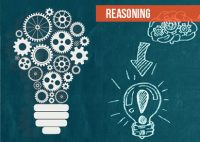Mathematical Operation For SBI PO Set – 6

Mathematical Operation For SBI PO Set – 6
1) Statement:
A > B > C, D > E> F, D > C
Conclusions:
I. E > C
II. F > B
a) If only Conclusion I follows
b) If only Conclusion II follows
c)If either Conclusion I or II follows
d) If neither Conclusion I nor II follows
e) If both conclusions I and II follow.
2) Statement:
A ≥ B = C, D > C = E
Conclusions:
I. E >A
II. A < D
a) If only Conclusion I follows
b) If only Conclusion II follows
c) If either Conclusion I or II follows
d) If neither Conclusion I nor II follows
e) If both conclusions I and II follow.
3. H ≥ I = J ? K ≤ L < M
a) >
b) ≥
c) ≤
d) Either < or ≤
e) None
4) P $ Q means P is not smaller than Q.
P © Q means P is neither greater than nor smaller than Q.
P @ Q means P is not greater than Q.
P × Q means P is neither smaller than nor equal to Q.
P # Q means P is neither greater than nor equal to Q.
Statements:
H @ V, V © M, M × R
Conclusions:
I. R × H
II. H $ R
a) If only conclusion I is true
b) If only conclusion II is true
c) If either I or II is true
d) If neither I nor II is true
e) If both I and II are true
5) In the following questions, the symbols #, $, @, * and © are used with the following meaning as illustrated below:
‘P # Q’ means ‘P is not smaller than Q
‘P $ Q’ means ‘P is neither smaller than nor greater than Q’
‘P @ Q’ means ‘P is neither greater than nor equal to Q’
‘P * Q’ means ‘P is not greater than Q’
‘P © Q’ means ‘P is neither smaller than nor equal to Q’
Statements:
B $ K, K @ D, D # M
Conclusions:
I.B $ M
II. B @ M
a) If only Conclusion I is true
b) If only Conclusion II is true
c) If either Conclusion I or II is true
d) If neither Conclusion I nor II is true
e) If both Conclusion I and II are true
6. For the following questions
& Means ‘greater than’
∆ means ‘is smaller than’
O means ‘is equal to’
× Means ‘Plus’
= means ‘minus’
If a & c and b× d O c, then
a) d &a
b) a O d
c) b & c
d) d ∆ a
e) c & a
f) d & a
7) In the questions given below, certain symbols are used with the following meaning.
A @ B means A is greater than B.
A * B means A is either greater than or equal to B.
A # B means A is equal to B.
A $ B means A is either smaller than or equal to B
A + B means A is smaller than B
Statements:
B + D; E $ T; T * P; P @ B
Conclusions:
I.P $ D
II. P @ D
a) if only conclusion I is true
b) if only conclusion II is true
c) if either conclusion I or II is true
d) if neither conclusion I nor II is true.
e) if both conclusions I and II are true.
8. A @ B means A is greater than B.
A * B means A is either greater than or equal to B.
A # B means A is equal to B.
A $ B means A is either smaller than or equal to B
A + B means A is smaller than B
Statements:
D + T; E $ V; F * T; E @ D
Conclusions:
I. V * D
II. E @ T
a)if only conclusion I is true
b) if only conclusion II is true
c) if either conclusion I or II is true
d) if neither conclusion I nor II is true.
e) if both conclusions I and II are true.
9) Statement: P ≥ Q = R > S > T
Conclusions:
I. P ≥ T
II. T < Q
a) If only Conclusion I follows
b) If only Conclusion II follows
c)If either Conclusion I or II follows
d) If neither Conclusion I nor II follows
e) If both conclusions I and II follow.
10. Statement:
L ≤ M < N > O ≥ P
Conclusions:
I. O < M
II. P ≤ N
a) If only Conclusion I follows
b) If only Conclusion II follows
c) If either Conclusion I or II follows
d) If neither Conclusion I nor II follows
e) If both conclusions I and II follow.


